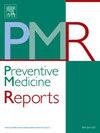肠道菌群饮食指数与慢性肾脏疾病之间的关系:一项来自美国人群的横断面研究
IF 2.4
3区 医学
Q2 PUBLIC, ENVIRONMENTAL & OCCUPATIONAL HEALTH
引用次数: 0
摘要
目的:新出现的证据表明,饮食调节肠道微生物群,进而影响慢性肾脏疾病(CKD)的进展。本研究探讨了新提出的肠道微生物群膳食指数(DI-GM)与CKD患病率和预后之间的关系。方法:本横断面研究分析了2007-2020年美国国家健康与营养检查调查的数据。DI-GM评分是根据14种食物成分的膳食摄入量计算的,分为有益和不利两类。采用加权线性回归模型、logistic回归模型和限制性三次样条分析来评估DI-GM与CKD的关系。结果:28512名参与者中CKD患病率为17.4%。高DI-GM与CKD患病率呈负相关(OR = 0.967, 95% CI: 0.939 ~ 0.995, p = 0.026),与非常高危预后呈负相关(OR = 0.877, 95% CI: 0.821 ~ 0.937, p <;0.001)。有益DI-GM成分与降低CKD风险显著相关(OR = 0.928, 95% CI: 0.892-0.966, p <;0.001),而没有观察到不利因素的显著关联。较高的DI-GM和有益的DI-GM水平与CKD预后改善呈线性相关(p为趋势值<;0.001)。咖啡和纤维是CKD患病率和预后的主要因素,而全谷物主要影响其预后。结论:在有益饮食成分的驱动下,较高的DI-GM与降低CKD患病率和改善预后相关。这些发现表明,促进有益的饮食模式以增强肠道微生物群可能在CKD管理中发挥关键作用。本文章由计算机程序翻译,如有差异,请以英文原文为准。
Association between dietary index for gut microbiota and chronic kidney disease: A cross-sectional study from U.S. population
Objective: Emerging evidence suggests that diet modulates gut microbiota, which in turn influences chronic kidney disease (CKD) progression. This study investigates the association between the newly proposed Dietary Index for Gut Microbiota (DI-GM) and the prevalence and prognosis of CKD.
Methods: This cross-sectional study analyzed data from the U.S. National Health and Nutrition Examination Survey 2007–2020. DI-GM scores were calculated based on dietary intake of 14 food components, categorized as beneficial or unfavorable. Weighted linear regression model, logistic regression model, and restricted cubic spline analysis were used to assess the associations of DI-GM with CKD.
Results: The prevalence of CKD among 28,512 participants was 17.4 %. Higher DI-GM was negatively associated with CKD prevalence (OR = 0.967, 95 %CI: 0.939–0.995, p = 0.026) and with very high-risk prognosis (OR = 0.877, 95 %CI: 0.821–0.937, p < 0.001). Beneficial DI-GM components were significantly associated with lower CKD risk (OR = 0.928, 95 %CI: 0.892–0.966, p < 0.001), while no significant association was observed for unfavorable components. Higher DI-GM and beneficial DI-GM levels were linearly associated with improved CKD prognosis (p for trend <0.001). Coffee and fiber were primary contributors to both the prevalence and prognosis of CKD, while whole grains primarily impacted its prognosis.
Conclusions: Higher DI-GM, driven by beneficial dietary components, is associated with reduced CKD prevalence and improved prognosis. These findings suggest that promoting beneficial dietary patterns to enhance gut microbiota may play a pivotal role in CKD management.
求助全文
通过发布文献求助,成功后即可免费获取论文全文。
去求助
来源期刊

Preventive Medicine Reports
Medicine-Public Health, Environmental and Occupational Health
CiteScore
3.90
自引率
0.00%
发文量
353
 求助内容:
求助内容: 应助结果提醒方式:
应助结果提醒方式:


